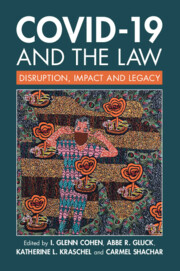The chapters that follow in Part V of this volume illustrate how COVID-19’s disruptive pressure on health care delivery and access served as a catalyst for change. These chapters show that the analogy to a catalyst in a chemical reaction is apropos, demonstrating how COVID-19:
(1) sped up but did not create novel modalities of health care delivery and treatment; (2) created new pathways to care through various legal and policy changes; and (3) ushered in changes that may or may not have sustained impact.
First, in chemistry, a catalyst speeds up a reaction but does not create one itself. Each of the chapters in Part V describes an innovation in delivery or pathway around barriers to access that existed prior to COVID-19 but whose uptake was sped up in the face of the pressures of COVID-19. In Chapter 18, “Telehealth Transformation in COVID-19,” Ryan Knox, Laura Hoffman, Asees Bhasin, and Abbe Gluck emphasize that telehealth has existed for more than seventy years and describe the long-standing barriers to embracing it – from payment to licensing, prescribing, and privacy laws, and more. In Chapter 19, “Changes in the Provision of Take-Home Methadone for People with Opioid Use Disorder During the COVID-19 Pandemic: Implications for Future Policymaking,” Dr. Zoe Adams, Taleed El-Sabawi, Dr. William Coe, Hannah Batchelor, Janan Wyatt, Mona Gandhi, Dr. Ida Santana, and Dr. Ayana Jordan point to evidence supporting the safety and effectiveness of methadone to treat opioid use disorder (OUD) that predate the pandemic. In Chapter 20, “Reproductive Justice After the Pandemic: How ‘Personal Responsibility’ Entrenches Disparities and Limits Autonomy,” Rachel Zacharias, Elizabeth Dietz, Kimberly Mutcherson, and Josephine Johnston describe the pre-pandemic consensus that in-person requirements for medication abortion provision were unnecessary. Similarly, in Chapter 21, “Abortion At-Home and At-Law During a Pandemic,” Joanna Erdman describes the unrealized revolutionary potential of medication abortion that has been lying in wait since its first uses in the 1980s.
The first three chapters in Part V point to problematic sources of regulatory barriers to access. As Dr. Adams and her coauthors state, “[r]ooted in racialized understandings of criminality, methadone has been regulated for protection of ‘the public,’ rather than for the safety, efficacy, and treatment of people with OUD.” In addition, Zacharias, Dietz, Mutcherson, and Johnston depict the entrenched notions of personal responsibility and blameworthiness that took a backseat in the name of reducing the risk of viral spread and uncover readily available, reproductive justice-enhancing alternatives.
Second, a catalyst speeds up a reaction by creating lower energy pathways to the end state of the reaction. The chapters in Part V show where the system was before COVID-19, including the legal, regulatory, and political structures in place, and how racism and sexism manifest as barriers to effective care. They also detail how government responses elicited by COVID-19 shepherded changes, creating new pathways. Knox and his coauthors detail the rapid change to both state and federal laws that allowed the unprecedented growth of telehealth, largely in a synergistic way between federal law, governing issues such as Medicare reimbursement and privacy, and state laws, governing licensure. The other three chapters in Part V tell a slightly different story of how state and federal laws can work against one another – one looking to maintain the status quo, the other forging a new pathway to access. They show us how COVID-19 acted as a catalyst to motivate government actors to open new pathways to an end state that mitigates some of the pitfalls of the system at the outset and provides a roadmap for similar models in the future.
Finally, a catalyst’s effect depends upon whether the reaction is reversible or irreversible. If it is irreversible, the catalyst speeds up the reaction and results in newly formed substances that cannot react with one another to return to the pre-reaction state. If the reaction is reversible, the catalyst serves to move the reaction along more quickly, but to an equilibrium in which some of the new products react to return to the original state. Taken collectively, the chapters in Part V tell a story of accelerated uptake of forward-looking models of care. Some show how COVID-19 expedited the demolition of barriers to care that were largely unsupported by evidence and based in racism and sexism. They also illustrate the precariousness of their longevity and the complexities of laws governing health care. Knox and his coauthors note that the Centers for Medicare and Medicaid Services have made some changes permanent by adding several telehealth services to the list of covered services, while noting that many other changes have sunsetted or are slated to sunset. They also discuss the remaining challenges for telehealth, including perpetuating disparities in accessing care and fraud, and call for continued research and regulatory innovation. Dr. Adams and her research team summarize the growing body of peer-reviewed literature and share their own study that provides concrete evidence of the safety and patient satisfaction of take-home doses of methadone for patients with OUD. Zacharias and her coauthors argue for the reproductive justice-enhancing changes
COVID-19 facilitated to serve as proof of concept for further, long-lasting reforms. Finally, Erdman describes how COVID-19 brought abortion into the home and contemplates the feedback loop that will continue between abortion at-home and laws that govern its provision.
What these chapters make abundantly clear is that no one law, no one body – legislative, regulatory, executive, or judicial – can work in isolation to maintain the gains realized during the pressures of the pandemic. Similarly, no entity alone can ensure lasting improvements or that the barriers removed during COVID-19 are not reconstructed. Time will tell whether COVID-19’s catalytic power to reform health care delivery and remove barriers to access will be a lasting legacy of change or a brief snapshot in time.

